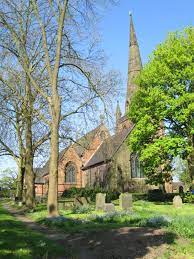The "ancient redstone edifice" of St. Margaret's, Wolstanton, is a landmark in the Potteries, "seated on an eminence, its lofty spire forms a conspicuous feature in this part of the country." In 1863, a serious charge against the longtime vicar of the church excited considerable interest.
The Rev John Tyson had been in Wolstanton for more than 25 years. One of a clergyman's duties was to sit with the sick and provide some spiritual comfort. Thus did the vicar spend many hours in the cottage of Mrs. Mary Ann Barlow whose mother was dying. Mrs. Barlow was a widow in her 30's; she'd been born in the village, her late husband had been a schoolmaster and local relief officer. She was quite a respectable woman. Mr. Tyson's regular calls continued until the death of her mother in September 1862.
A few days after Christmas, a letter arrived at the vicarage, signed by Mary Ann Barlow. As the letter formed the centerpiece of the case against Rev. Tyson, it is quite unfortunate that it did not survive. On that occasion, the vicar read it aloud, in the presence of his wife and his nephew. From memory, they all recalled words to the effect that "The secret's in and must come out. I should have sent this letter after the second offence, but I was afraid if I had done so you would refuse to visit my mother. Your ingratitude is very base, after my having endured this so long. I must be paid, and receive compensation for the loss of peace of mind which I have sustained. Oh, that it were with me as in days past, when I could attend church, and receive the sacrament with inward and spiritual grace." When she heard the letter read, Mrs. Tyson turned to her husband, "Why John, she means to accuse you of having improper intercourse with her."
On New Year's Day, Mrs. Barlow was taken into custody by a local plod who recalled she told him how she had to fight the vicar off. "He put his hand up my skirt but I pushed him away and resisted him." At the Police Court in Stoke, the woman was charged with extortion with threats, namely that the Rev. Tyson had attempted to commit a rape upon her person.
Amidst a great deal of public interest and excitement, the case was heard in March at the Spring Assizes in Stafford. The Rev. Tyson, in his 60's and in delicate health, had lived a blameless and irreproachable life. Not a breath of scandal touched his name, his counsel told the court. On the stand, the vicar denied a litany of alleged improprieties. During his many visits, he never bolted the door in Mrs. Barlow's home, he never pulled down the blinds, he never sat on the sofa with the woman, she never sat on his knee, he never put his arm round her waist or up her skirt. He was never with her in her bedroom; he never pushed her down and lay with her on the bed. He never wrote to her begging that she not reveal his past wrongdoing.
What motivation would a respectable lady have for making such a horrible charge? In that lost letter, there was also mention that Mrs. Barlow had asked the vicar for a loan of £30 which he had refused. At that time, Mrs. Barlow, the accused, could not take the stand in her defense. Representing her was Henry Matthews Q.C., a future Home Secretary. He made a lengthy speech insisting that the "wrong construction" had been placed upon that letter. Her mother had just died, she was in great need, and her pastor and spiritual adviser for twenty years, her friend and consoler in time of trouble, and with whom for years she'd worked as a Sunday School teacher, refused to help her. After the letter was delivered, she went to the vicarage to see Mr. Tyson, but his solicitor turned her out. Matthews suggested to the jury that, had she been allowed to talk to the vicar - before her mouth was closed in the dock - she could have explained her situation and her despair and that she had never intended to impute anything reflecting upon his character.
Baron Channell admitted the jury had two very different versions of events. The letter had been “imprudently parted with” and, without it, its full contents were unknown. It was a serious charge against Mrs. Barlow; one that would come with a lengthy jail term if she was convicted. The jurymen, "after a brief consultation," acquitted her.
The verdict left the entire sordid matter unresolved. In Wolstanton, 400 parishioners signed a statement offering their support to Mr. Tyson "for his considerable annoyance of late." Their confidence remained unabated in his ministry and character. In his grateful reply, the vicar admitted "the only consolation remaining to me is a clear conscience before my Almighty Master." The Rev. John Tyson remained at St. Margaret's, Wolstanton, until his death four years later. There is a memorial to his memory in the church today.
For this Christmas, consider this collection of stories of Victorian clergymen and their predicaments.


No comments:
Post a Comment
Comments are always welcome. I am keen to learn more, make corrections, or discuss. Thanks for visiting.